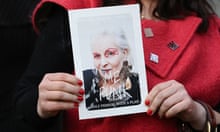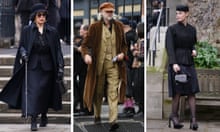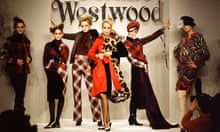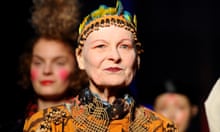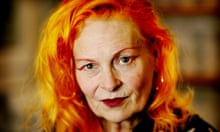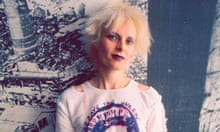The first time I saw a Vivienne Westwood dress in the wild was while shopping for my best friend’s wedding, almost 10 years ago. She told me she wanted something black, not white, something in the sale, something she could wear after the wedding and – turning to face me on the middle of London’s Regent Street, added: “something that will stretch because I’m six weeks pregnant”. So off we went to the Vivienne Westwood store on Conduit Street in London, and left half an hour later with a loose black silk sleeveless pencil dress, with a draped neckline and ruched waist with plenty of give. She successfully wore it, five weeks later and 11 weeks pregnant, to her wedding.
Vivienne Westwood, who died on Thursday night, could pack more contradictions into one collection than most designers could in a lifetime. But in her clothes, she did the one thing designers are unable – or rather unwilling – to do. That is, make fancy stuff for real people with real bodies, making her truly the mother of all fashion contradictions.
Probably more famous for her transgressive marriage of punk and fashion in the late 70s – for dressing the Sex Pistols in rips, and Adam and the Ants in Elizabethan blouses – it wasn’t until the late 80s and 90s that Westwood began making proper tailored clothes by dissecting existing pieces, inadvertently changing the landscape of high-end womenswear.
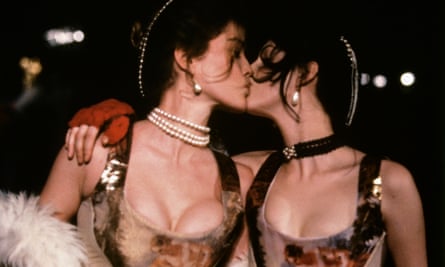
The best example is perhaps her 1990 Portrait Collection show. Here, skirts were full, waists were boned and bosoms spilled. The models who took part in her shows were thin – but in spite of this, some of the clothes seemed to support their wearer, somehow making them look fuller. Removed from their catwalk context, they didn’t just expand the definition of acceptable body type; they encouraged it.
This was part of Westwood’s shtick, of course. If trends went one way, she went another. But at the time, viewed between the wide-shouldered soft power of fashion’s main New York players such as Donna Karan and the “heroin chic” thriving within its subcultures, Westwood’s 90s aesthetic was an outlier, exaggerating the female form rather than reducing it. The 18th-century-inspired gowns were not outrageous because they showed their wearer’s knickers, but because they understood what fashion for women with breasts and bums wasn’t – which was fashionable.
“All my clothes are really sexy, about meeting the body and making it look attractive and powerful,” she said, at the 2004 launch of her V&A retrospective. “I aim to make people look important.” Among her fans were undoubtably famous and powerful women – most famously the artist Tracey Emin, the actor Christina Hendricks (who also fronted a Vivienne Westwood campaign in 2011) and the shape shifter Kim Kardashian. Celebrities, yes, but also women with bodies who relied on clothes that celebrate the female form.
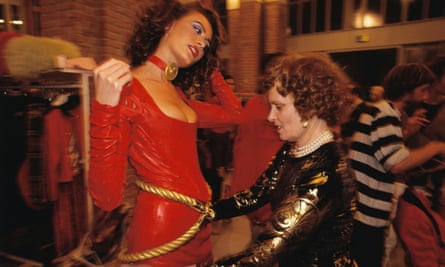
Not everything Westwood made in the 90s was about wearability, of course. Just ask teenage Naomi Campbell, who fell on her 1993 catwalk in 9in platforms, or Kate Moss, who in 1995 walked out wearing just a skirt while eating a Magnum. Nor is body image something Westwood particularly wanted to interrogate with her clothes (it’s telling that in a 2018 documentary, she described her approach to fashion not as attacking the establishment, but as “a distraction”). She cared about animals, and was a vegetarian, but partly because her favourite food was lettuce – she once alleged that she and her husband, Andreas, went through one iceberg a day.
It could also be said that Westwood, perhaps hypocritically, deployed nudity as a shock tactic rather than anything more helpful, particularly later in her career. When Pamela Anderson, her one-time muse – in politics too, with both campaigning for the release of Julian Assange – walked in a show in 2009, and revealed a nipple during the final bow, the effect was mainly comic.
Still, as someone who dressed punks, then supermodels, translating the shock tactics of one movement into the other through plaid and scissor-work, she pioneered a rebelliousness that often led to change. In 2017, her catwalk show was one of a few that season to include menswear and womenswear. What seemed like a gimmick then was actually fairly progressive – this is fairly normal practice now. Still, as the clothing was sold in separate departments, the only real way to identify the unisex stuff was to check the label.
Not all catwalk shows have real-world impact – and as empowering as it was to see heaving bosoms on her catwalks, how many women think of a catwalk show when hunting for something to wear? They did with Vivienne Westwood. As my pregnant friend walking down the aisle in a black dress proves, the clothes actually worked for women in the real world.
Morwenna Ferrier is the Guardian’s fashion and lifestyle editor



